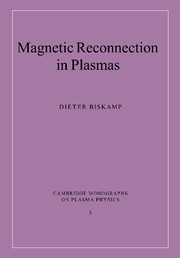3 - Current sheets
Published online by Cambridge University Press: 23 December 2009
Summary
In an electrically conducting magnetized plasma even slow motions do not, in general, preserve a smooth magnetic field, but give rise to sheetlike tangential field discontinuities, called current sheets. These are the natural loci of magnetic reconnection. In this chapter we consider the properties of current sheets and reconnection via current sheets in the traditional framework of resistive magnetohydrodynamics (MHD). This restriction is justified, since macroscopic current sheets mostly occur, when the reconnection process R in Ohm's law (2.1) is dissipative. Collisionless reconnection processes, which are treated in chapters 6 and 7, usually give rise to microcurrent sheets.
The chapter starts with a brief introduction to MHD theory, discussing the basic equations, magnetostatic equilibria, and linear MHD waves. In low-β plasmas it is often convenient to eliminate the fast compressional MHD wave by using a reduced set of equations. In section 3.2 we first consider the conditions under which a current sheet arises and how it is formed by rapid thinning, which continues until finite resistivity leads to a stationary sheet configuration. Then the structure of a resistive current sheet, called a Sweet–Parker sheet (Sweet, 1958; Parker, 1963), is analyzed. While the global properties of such sheets follow from the basic conservation laws, the detailed structure requires a more specific analysis. Section 3.3 deals with the role of current sheets as centers of reconnection in a magnetic configuration. Syrovatskii (1971) has developed a simple and elegant theory of current sheets which captures many features of the fully dynamic resistive theory, in particular the complicated structure of the sheet edges, the so-called Y-points.
- Type
- Chapter
- Information
- Magnetic Reconnection in Plasmas , pp. 29 - 80Publisher: Cambridge University PressPrint publication year: 2000
- 2
- Cited by



